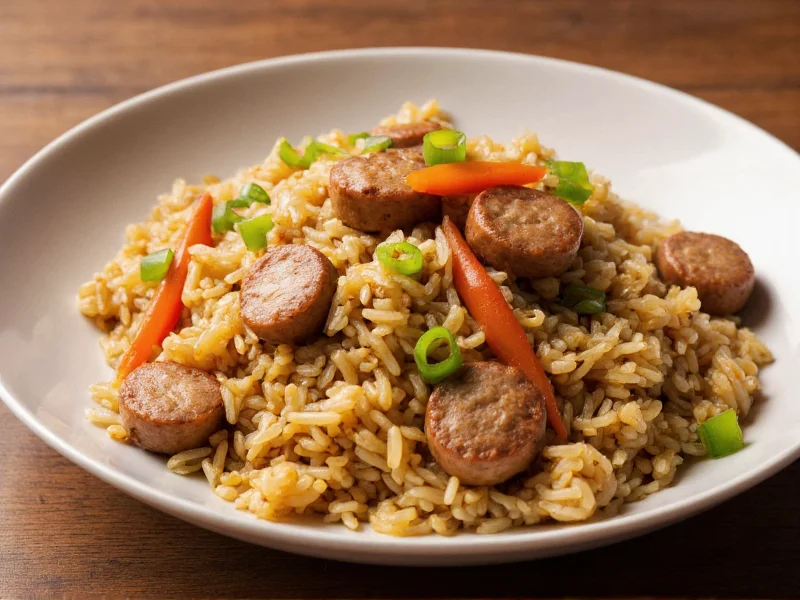Sausage fried rice has become a beloved staple in Asian cuisine and home kitchens worldwide. This versatile dish transforms simple ingredients into a flavorful meal that works equally well as a quick weeknight dinner or a restaurant-quality presentation. Unlike traditional fried rice, the addition of Chinese sausage (lap cheong) provides a distinctive sweet-savory note that elevates the entire dish.
Essential Ingredients for Authentic Sausage Fried Rice
The magic of exceptional sausage fried rice begins with ingredient selection. While variations exist across regions, certain components remain fundamental to achieving authentic flavor and texture.
Choosing the Right Sausage
For best sausage for fried rice applications, Chinese lap cheong stands unmatched. This dried, sweet pork sausage contains notes of rose wine, soy sauce, and sugar that permeate the rice during cooking. When shopping for Chinese sausage fried rice ingredients, look for firm, glossy sausages without discoloration. If lap cheong proves difficult to find, quality alternatives include:
| Sausage Type | Flavor Profile | Best Usage Tip |
|---|---|---|
| Lap Cheong (Chinese) | Sweet, savory, slightly smoky | Steam 10 minutes before slicing |
| Chorizo (Spanish) | Spicy, paprika-forward | Use sparingly due to stronger flavor |
| Andouille | Peppery, smoky | Balance with extra sweetness |
| Italian Sweet | Herbaceous, fennel notes | Add 1 tsp sugar to compensate |
Rice Selection and Preparation
The foundation of easy sausage fried rice recipe success lies in proper rice handling. Contrary to popular belief, freshly cooked rice creates mushy results. Instead, use chilled, day-old rice with these characteristics:
- Texture: Firm, separate grains that maintain structure during stir-frying
- Moisture content: Approximately 12-14% for optimal frying performance
- Variety: Medium or long-grain white rice (Jasmine works exceptionally well)
For those wondering how to make sausage fried rice without leftovers, spread freshly cooked rice in a thin layer on a baking sheet and refrigerate uncovered for 2-3 hours before use.
Step-by-Step Cooking Method
Mastering the technique transforms homemade sausage fried rice from ordinary to extraordinary. Follow these professional steps for restaurant-quality results:
Preparation Phase
- Slice 2 Chinese sausages diagonally into ¼-inch pieces
- Prepare 3 cups chilled cooked rice (break up clumps with wet fingers)
- Mince 2 cloves garlic, 1 inch ginger, and 2 green onions (separate white and green parts)
- Whisk together 2 tbsp soy sauce, 1 tbsp oyster sauce, 1 tsp sesame oil, and ½ tsp sugar
Cooking Sequence
- Heat wok or large skillet over maximum heat until smoking slightly
- Add 1 tbsp neutral oil (peanut or canola), swirl to coat surface
- Cook sausage 2-3 minutes until edges crisp and oil renders
- Add aromatics (garlic, ginger, white parts of green onions), stir 30 seconds
- Incorporate ½ cup mixed vegetables (peas, carrots, corn), cook 1 minute
- Create well in center, add beaten eggs, scramble until just set
- Add rice, breaking up any remaining clumps with spatula
- Pour sauce mixture over rice, toss continuously for 2-3 minutes
- Finish with green onion tops, remove from heat immediately
Pro Tips for Perfect Sausage Fried Rice
Professional chefs employ these techniques when preparing authentic sausage fried rice that consistently delivers exceptional results:
- Temperature control: Maintain high, consistent heat throughout cooking—this prevents steaming and ensures proper wok hei (breath of the wok)
- Sauce application: Mix sauces before adding to avoid uneven seasoning; add in a circular motion for even distribution
- Rice-to-ingredient ratio: Maintain 3:1 ratio of rice to other ingredients for balanced flavor without overwhelming the star ingredient
- Minimal moisture: Pat vegetables dry before adding to prevent steam that would make rice soggy
Delicious Variations to Explore
Once you've mastered the quick sausage fried rice dinner basics, experiment with these popular adaptations:
Regional Twists
- Hong Kong Style: Add shrimp and Chinese lap cheong for a seafood-sausage combination
- Thai-Inspired: Substitute lap cheong with Thai chili sausage and add fish sauce
- Korean Fusion: Incorporate gochujang and kimchi for spicy complexity
Dietary Adaptations
- Healthy sausage fried rice: Use turkey sausage, increase vegetable content to 40%, and reduce oil by half
- Vegetable sausage fried rice: Replace meat sausage with mushroom-based vegetarian alternative
- Leftover sausage fried rice: Transform unused cooked sausage into next-day meal with additional egg and fresh scallions
Common Mistakes to Avoid
Even experienced cooks encounter challenges with sausage fried rice. Steer clear of these frequent errors:
- Overcrowding the pan: Cook in batches if necessary—crowding lowers temperature and creates steam instead of sear
- Adding wet ingredients: Ensure all vegetables are thoroughly dried before cooking
- Excessive sauce: Too much liquid makes rice soggy; start with recommended amounts and adjust
- Insufficient preheating: Wok must be properly heated before adding oil to prevent sticking
Serving Suggestions and Pairings
Complete your sausage fried rice experience with these professional presentation tips:
- Serve immediately in pre-warmed bowls to maintain optimal temperature
- Garnish with additional sliced green onions and sesame seeds
- Pair with simple egg drop soup for a complete meal
- Accompany with steamed bok choy or gai lan for vegetable balance
- Offer chili oil or Sriracha on the side for heat customization











 浙公网安备
33010002000092号
浙公网安备
33010002000092号 浙B2-20120091-4
浙B2-20120091-4